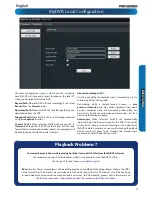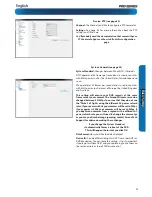
English
14
Basic S
etup
NTP
NTP stands for “Network Time Protocol”.
It’s a way for the DVR to automatically
update its internal clock and ensure it’s
always in sync. There’s no requirement
to use NTP, but it’s easy to setup and
free to use, so there’s really no reason
not to.
NTP Server:
The server you’d like to use
for NTP. They’re all quite comparable
in terms of reliability and accuracy, so
unless you’ve got some kind of master
plan for world domination (which is
affected by the time, for some reason)
then the default (
pool.ntp.org
) works
fine.
NTP Port:
The default is
123
. You
should only change this if you’re using
a different NTP server, and you know
they use a different port.
If you’re using
pool.ntp.org
, ensure the port is 123.
Sync:
Triggers the DVR to automatically synchronize its internal clock with the time server immediately. If your DVR is connected
to the Internet and the network is correctly configured, this will update almost instantly.
System Time:
The DVR’s current clock reading.
DST Configuration
You can configure the DVR to
automatically update it’s internal clock
when daylight saving starts and ends.
Note that using DST and NTP
simultaneously can cause problems,
depending on your NTP server and how
DST works in your locale.
Enable:
Whether the DVR will
automatically adjust the time for DST or
not.
Offset:
The amount by which the time
changes during DST. For the vast majority
of locations, the offset is one hour, but
exceptions to this rule exist.
Start Time / End Time:
When DST begins
and ends in your locale.
Basic Setup: NTP & DST





























